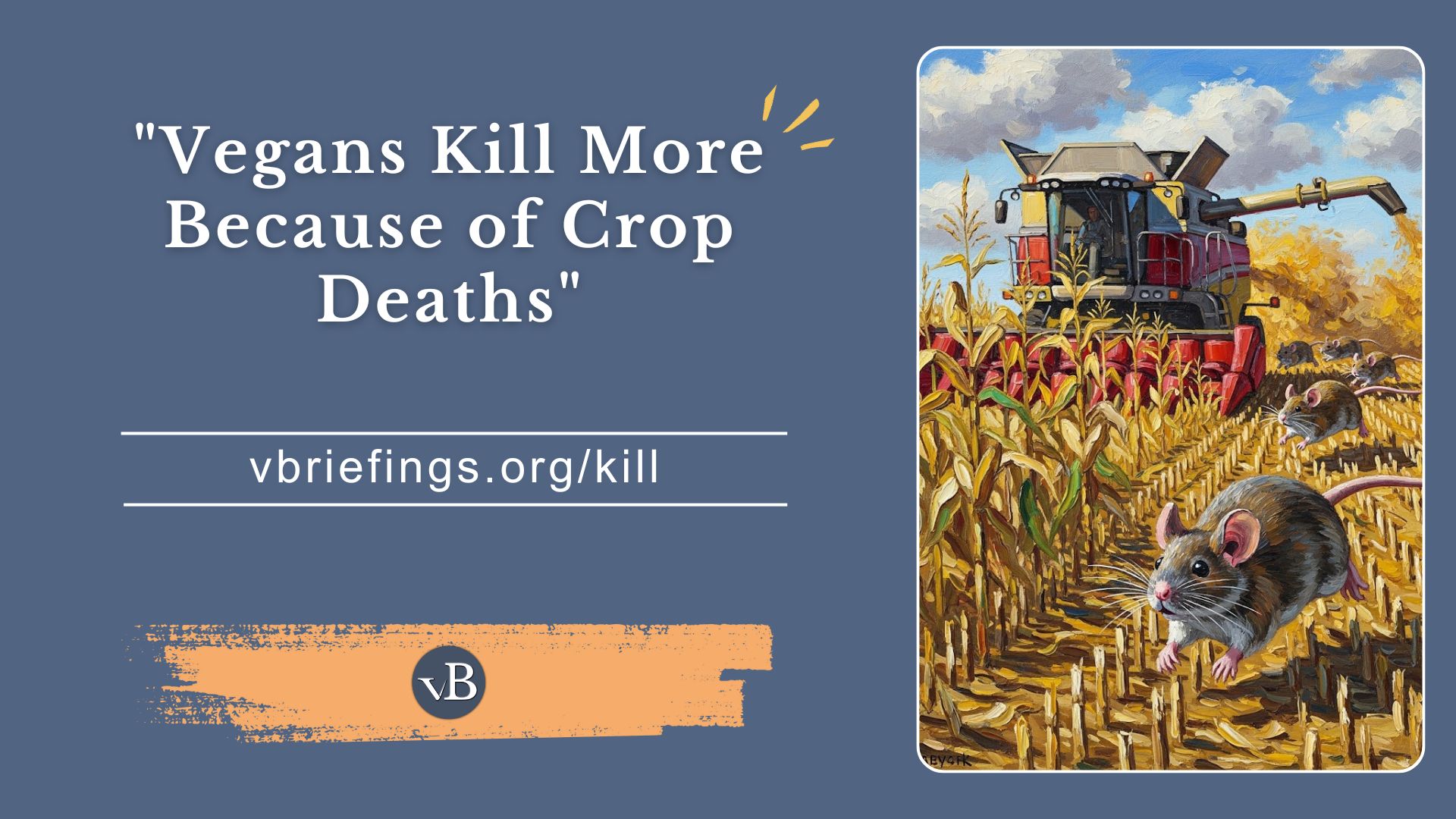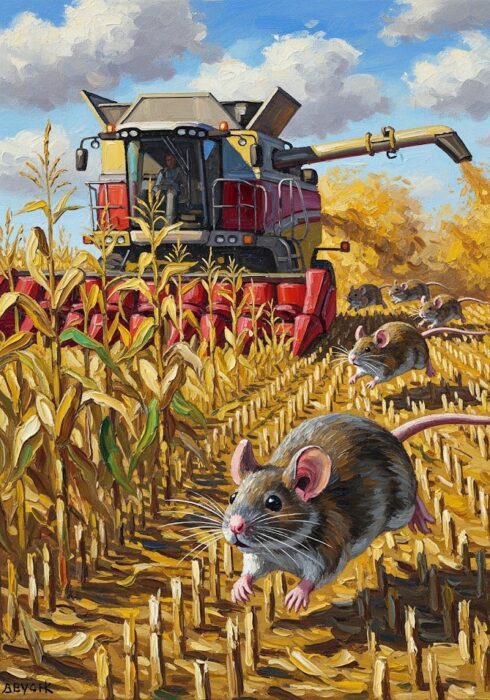Preface
Briefing description and more.
This briefing explains why using crop deaths as an argument against veganism doesn’t hold up.
Companion Videos
How to use companion videos
Videos may be posted on multiple social media platforms, and you can share them on each platform according each platform’s conventions.
Share this Briefing
Social Media Sharing Image
This image will be used when sharing the briefing on a social media platform. You can see all social sharing images in the grid view.

How to share this briefing
Click on the icon for the platform on which you wish to share. What happens next depends on the platform, but generally a popup will appear, letting you add your own text as you share.
Briefing Meta
Metrics
Note: we will publish additional briefings after completing flashcards and presentation slides for selected briefings.
Counts:
| Main Text | |
| Key Points | 5 |
| Counterclaims | 1 |
| Supplementary | 2 |
| Further Study | 5 |
| Footnotes | 25 |
| Media & Advocacy | |
| Advocacy Notes | 9 |
| —Socratic Questions | 8 |
| Flashcards | 61 |
| Presentation Slides | 0 |
| Memes & Infographics | 0 |
| Companion Videos | 0 |
Other Meta:
Date Posted:
Last Edited:
Edit Log:
Key Points Links
Loading…
Help Us Improve
Please send your suggestions for improvements, or report any issues with this briefing to team@vbriefings.org
We appreciate that you are taking the time to help up improve. All suggestions and reports will be carefully considered.
Summary
A concise summary of the briefing (see below for citations).
The claim that vegans kill more animals because of crop deaths collapses under scrutiny. Harvesting does cause some incidental deaths, but animal agriculture requires far more crops to feed farmed animals, multiplying those deaths and adding the deliberate slaughter of billions each year.
Furthermore, the “crop deaths” argument relies on studies that are poorly executed or misrepresented.
Just as important, intent matters: accidental deaths are not the same as systematic breeding and killing.
Also, the objection is an appeal to futility—the idea that if veganism isn’t perfect, it isn’t worth pursuing. In truth, veganism directly reduces suffering, challenges deliberate exploitation, and tackles the greatest threat to animals and biodiversity: the vast land and resource demands of animal agriculture.
Context
Places this topic in its larger context.
If it were true that plant-based diets caused more total animal deaths, that would be a serious challenge to veganism, which aims to minimize harm as far as possible. The “crop deaths” objection is part of a broader pattern of attempts to dismiss veganism by magnifying supposed flaws in plant-based agriculture while ignoring the far greater harms in animal-based systems.
This tactic—whether about crop deaths, plant sentience, or personal purity—is essentially an appeal to futility: the claim that because veganism cannot eliminate all harm, it is not worth pursuing at all. Such arguments deflect attention from the deliberate, large-scale killing inherent in animal agriculture and shift the discussion to marginal or hypothetical issues.
In doing so, they distract from the urgent reality: billions of sentient animals are intentionally bred, exploited, and slaughtered each year, while veganism is about rejecting avoidable violence and reducing suffering wherever possible.
Key Points
This section provides talking points.
When animals are raised for human food, not only are those animals slaughtered, but even more animals are lost in harvesting because farmed animals eat larger quantities of crops.
Over 75% of the world’s grains and soy used for food are fed to animals.1
Eating animal products instead of eating crops creates a multiplier effect: each calorie of meat, dairy, or eggs requires many more calories of harvested plant crops, contributing to more incidental animal deaths.
- On average, it takes 24 calories of harvested crops to produce just one calorie of animal-based food for humans (World Resources Institute, “Creating a Sustainable Food Future”).2
Animal agriculture is so inefficient because most of the feed calories consumed by an animal go toward energy for daily living. Also, some energy is expended to produce body parts that are not consumed (Applied Animal Nutrition Journal, “Energy Requirements of Livestock”).3
The “crop deaths” argument relies on studies that are poorly executed or misrepresented.
On an episode of the Joe Rogan podcast, Chris Kresser mentioned4 the 2018 research paper5 “Field Deaths in Plant Agriculture” by Bob Fischer and Andy Lamey to support the claim that approximately 7.3 billion animals are killed annually by plant agriculture in the United States.
However, rather than supporting Kresser’s claim, the paper questioned earlier research by Steven Davis and Michael Archer that supports that number. The authors say that the 7.3 billion number is “clearly too high” and rests on “dubious assumptions,” “absence of evidence,” and “calculation errors.”6
Even if the 7.3 billion number was accurate, more than that number of land animals are slaughtered annually for food in the United States. If you include fish in the equation, well over 55 billion are killed annually in the United States.7
Animals can flee harvesting machines.
Steven Davis and Michael Archer’s widely cited claims—that lower post-harvest counts of field animals are due to deaths—seem to ignore the likelihood that animals flee when disturbed by the noise and activity of harvesting machinery.
- At least two studies, one in Argentina and one in South Dakota, determined that animal counts after harvesting were predominantly from movement and migration, not harvesting machines.8
There is a moral difference between incidental and intentional killing.
It’s true that some field animals are killed during plant harvesting, but there’s an important ethical distinction: vegans do not intentionally exploit or kill animals.
- Intent matters: Causing unintentional harm while trying to reduce suffering is ethically different from breeding animals into existence specifically to kill them.
- Slaughter is not incidental—it’s systemic. More than 80 billion animals are deliberately killed for food every year.9 Crop deaths, while regrettable, are unintended and could potentially be mitigated.
- Incidental deaths happen in nearly every human system—farming, construction, and transportation all cause unintended human fatalities—yet we don’t use those tragedies to argue that humans don’t have rights. We shouldn’t abandon animal rights because perfection isn’t possible.
- For example, around 40,000 people die in vehicle accidents annually in the United States,10 but no one is calling for vehicles to be banned. If, however, someone directly and intentionally caused a highway death or paid someone to do so, they would be accountable under the law.
The biggest threat to wild animals isn’t combine harvesters—it’s the destruction of their homes to make way for grazing and feed crops.
Animal agriculture drives habitat loss and mass wildlife decline:
A 2023 sensitivity analysis published in Nature Food found that vegan diets reduce biodiversity loss potential by as much as 66%.11
A fully plant-based food system would free up three-fourths of agricultural land, or three billion hectares (7.4 billion acres), allowing for habitat restoration and massive reductions in species loss (Our World in Data, 2021).12
Animal agriculture uses 83% of global farmland while producing only 18% of total calories and 37% of protein. This is according to a 2018 J Poor-led study from Oxford, which has been called “the most comprehensive analysis to date of the damage farming does to the planet,” having examined 38,700 farms in 119 countries representing 90% of the world’s protein and calorie consumption. (The Guardian;13 “Reducing food’s environmental impacts through producers and consumers”, published in Science Magazine)14
Since the rise of humans and animal agriculture, wild mammal populations have declined by over 85%,15 and the biomass of livestock now outweighs that of wild mammals by 14 to 1.16
Counterclaims
Responses to some yes but retorts.
Claim: Grazed animals don’t require feed, so no animals are killed in harvesting.
To whatever extent grazing reduces the amount of feed used, that doesn’t change the reality that over 75% of the world’s grains and soy used for food are fed to animals17, as mentioned above.
We simply don’t have enough land—the US has enough pasture to support only 27% of the current beef production (Environmental Research Letters 2018).18
Grazed animals are often moved to a feedlot to be fed grains for 4 to 6 months of their 18-month (Food Transparency Project, 2020)19 existence before being slaughtered (The North American Meat Institute, 2015).20
- Livestock is particularly inefficient at converting feed calories to meat. If you average across the most used farmed animals, it takes 24 calories of harvested crops to produce just one calorie of animal-based food for humans. But for beef, the figure is 100—it takes 100 calories of harvested crops to produce just one calorie of beef. (World Resources Institute, “Creating a Sustainable Food Future”)21
Grazing contributes to habitat loss, as discussed in a key point above.
Supplementary Info
Additional information that may prove useful.
New farming methods (like no-till,22 veganic,23 and regenerative plant-based agriculture24) are being developed to reduce even unintentional wildlife harm.
Veganism doesn’t claim to eliminate all harm—it seeks to minimize suffering as much as possible and reject deliberate violence where it is avoidable.
Further Study
Sources providing a deeper understanding of the topic or related topics.
Other Resources
Ed Winters, “Debunked: Do Vegans Kill More Animals Through Crop Deaths?“, reinforces the points made here while offering a deeper dive into the weaknesses of the research behind the objection.
This Sentient video, “Do Vegans Kill More Animals Than Meat Eaters? Debunking the Crop Death Argument,” breaks down the crop‑death claim with journalistic rigor, unpacking the core of the argument and showing why it doesn’t hold up in evidence or logic.
This Debug the Brain video, “Vegan vs Carnivore: Who Kills More Animals?“, complements this briefing more directly by expounding on the counterclaim mentioned above that “grazed animals don’t require feed, so no animals are killed in harvesting.”
Advocacy Resources
Information to help with outreach and advocacy.
Note: we will publish additional briefings after completing flashcards and presentation slides for selected briefings.
Share This Briefing
Cloned from the Preface Section on page load.
Companion Videos
Cloned from the Preface Section on page load.
Memes and Infographics
No images found.
How to use Memes and Infographics
To sequence through all memes and infographics on this page, click on any image than use the arrow keys or the arrow buttons to show next and previous images.
To share a meme or infographic, right click on the image and choose download or save as. Then upload the image to the platform of choice.
Presentation Slides
Slides not available.
How to Use the Presentation Slides
You can view the slideshow full screen by clicking on the first link above.
To use Canva presenter mode, view the speaker notes, or download the slides as PowerPoint, login to Canva (the free account works) and follow the Full Canva Link provided above.
To copy this presentation to your own Canva project, use the Full Canva Link provided above, then select File->Make a Copy from the upper left. You can build your own unique presentation from multiple briefings by copying the presentation from each briefing and then building another presentation from the copied presentations.
Flash Cards
We partner with Brainscape because of their excellent features for learning. You will need to create a free Brainscape account to study the cards.
Go to Flash Cards: This will take you to a list of decks.
About Flash Cards and Brainscape
Flash cards are here to help you commit important facts and concepts in this briefing to memory.
In Brainscape, there is one deck for each briefing. You can study more than one deck at a time. Brainscape uses spaced repetition to promote memory retention. It is “the secret to learning more while studying less.”
You can study using your browser, but Brainscape also has a free mobile app that makes learning anywhere easy.
Socratic Questions
Socratic-style questions are embedded in the Advocacy Notes below, and shown in italics.
These are open-ended, thought-provoking questions designed to encourage critical thinking, self-reflection, and deeper understanding. They are inspired by the Socratic method, a teaching technique attributed to the ancient Greek philosopher Socrates, who would ask his students probing questions rather than directly providing answers.
The goal is to help people examine their beliefs, clarify their thoughts, uncover assumptions, and explore the evidence and reasoning behind their ideas.
Advocacy Notes
Ted Nugent on the Joe Rogan Podcast
In addition to the claims made on the Joe Rogan podcast mentioned above, similar claims were made on another episode of the podcast, this time featuring Ted Nugent.
In this case, they were presented without any supporting evidence—yet Rogan responded by saying, “That’s a really good point, and it’s a point that a lot of people ignore.”25
Tips for Advocacy and Outreach
Segue the Conversation Back to Animal Ethics
- “Even if incidental deaths occur during plant harvesting, how does that justify our intentional breeding, abuse, and violent slaughter of billions of farmed animals each year—animals who, incidentally, eat even more harvested crops?”
Why? This keeps the focus on the key difference between unintentional harm and purposeful exploitation, clarifying the ethical issue.
Focus on the Bigger Picture of Harm
- “If the goal is to cause the least harm, doesn’t it make sense to remove ourselves from the systems that cause the most suffering?“
Why? This clarifies that the ethical standard should be to reduce avoidable, large-scale suffering, not justify more of it.
Expose the Double Standard
- “How can someone criticize veganism for accidental deaths while continuing to support an industry that causes intentional suffering and killing on a massive scale?“
Why? This exposes the double standard and highlights the hypocrisy of using crop deaths as a moral objection.
Flip the Logic Back on the Argument
- “If plant agriculture causes some deaths, wouldn’t reducing the number of animals we farm—who eat enormous amounts of crops—reduce both farm animal suffering and crop deaths?“
Why? This flips the argument on its head, showing that veganism actually reduces overall harm.
Test Their Consistency
- “If you’re using crop deaths as a reason not to be vegan, does that mean you think causing fewer deaths is better—or not?“
Why? This encourages the person to examine whether their argument is grounded in genuine concern or just deflection.
Widen the Circle of Concern
- “Wouldn’t it be more consistent to care about all animal deaths—especially the ones we can directly control?“
Why? This reinforces the idea that moral concern should include farmed animals and not just incidental wildlife deaths.
Challenge the Justification
- “Do you think it makes sense to use one type of harm to justify a much larger and more deliberate form of harm?“
Why? This draws attention to the flawed logic behind the “vegans kill more” argument.
Encourage Moral Reflection
- “What does it say about our moral compass if we use the idea of some unintentional deaths to excuse billions of deliberate ones?“
Why? This invites reflection on personal accountability and ethical integrity.
Point Out Who’s Really Responsible for More Deaths
- “If vegans were responsible for every incidental death caused by crop harvesting, wouldn’t meat eaters be responsible for those plus the deaths of the animals they consume?“
Why? This exposes the logical failure of trying to blame vegans more than omnivores.
Acknowledge Avoidance and Redirect
- “Why do you think it’s easier for people to bring up incidental deaths rather than face the reality of how animals are treated in farms and slaughterhouses?“
Why? This opens space for discussing emotional avoidance and the real reasons people resist change.
Footnotes
Our sources, with links back to where they are used.
- The figures for soy and grain are documented separately here, before generalizing into one statement covering both. ↩︎
- The 24 to 1 figure was calculated from the table on page 37, figure 12, by averaging the ratios of calories in to calories out among the different animal products. For example, pigs consume 10 calories to get one calorie of pork out (100/10). If you average beef (100), milk (14), shrimp (14), pork (10), chicken (9), fin fish (8), and egg (13), you get 24. If sheep and buffalo milk were included, the average would be even more concerning.. “Creating a Sustainable Food Future.” World Resources Institute, 2013-2014 ↩︎
- James Rowe and John Nolan, Energy Requirements of Livestock. The Theory and Practice of Animal Nutrition, Applied Animal Nutrition Journal 2009 ↩︎
- Joe Rogan Podcast. “The Troublesome Truth behind the Fake Meat Industry.” JRE Clips, 21 Nov. 2019, youtu.be/j4uKfTxbhr4?t=344. ↩︎
- Fischer, B., Lamey, A. Field Deaths in Plant Agriculture. J Agric Environ Ethics 31, 409–428 (2018). https://doi.org/10.1007/s10806-018-9733-8. PDF Link ↩︎
- Fischer, B., Lamey, A. Field Deaths in Plant Agriculture. J Agric Environ Ethics 31, 409–428 (2018). https://doi.org/10.1007/s10806-018-9733-8. PDF Link ↩︎
- “Animal Clock.” 2025 U.S. ANIMAL KILL CLOCK, Humane Ventures, 2025. Accessed 8 Aug. 2025. Using USDA data, Animal Clock calculates that 9.7 billion land animals were slaughtered in 2020. ↩︎
- Fischer, B., Lamey, A. Field Deaths in Plant Agriculture. J Agric Environ Ethics 31, 409–428 (2018). https://doi.org/10.1007/s10806-018-9733-8. PDF Link ↩︎
- Rosado, Pablo. “More than 80 Billion Land Animals Are Slaughtered for Meat Every Year.” Our World in Data, 2024. Accessed 12 Aug. 2025. ↩︎
- “NHTSA Estimates 39,345 Traffic Fatalities in 2024.” NHTSA, U.S. Department of Transportation’s National Highway Traffic Safety Administration, 8 Apr. 2025. Accessed 12 Aug. 2025. Estimates are by the United States Department of Transportation. ↩︎
- Scarborough, P., Clark, M., Cobiac, L. et al. Vegans, vegetarians, fish-eaters and meat-eaters in the UK show discrepant environmental impacts. Nat Food 4, 565–574 (2023). The report states that “Dietary impacts of vegans were … 34.3% (12.0–65.3%) for biodiversity.” If vegans have 34.3% of the impact, then they are reducing the impact by the complement, 65.7%. ↩︎
- Ritchie, Hannah. “If the World Adopted a Plant-Based Diet, We Would Reduce Global Agricultural Land Use from 4 to 1 Billion Hectares.” Our World in Data, 4 Mar. 2021. Accessed 14 Aug. 2025. ↩︎
- Carrington, Damian, and Damian Carrington Environment editor. “Avoiding Meat and Dairy Is ‘Single Biggest Way’ to Reduce Your Impact on Earth.” The Guardian, May 31, 2018, sec. Environment ↩︎
- Poore, J., and T. Nemecek. “Reducing Food’s Environmental Impacts through Producers and Consumers.” Science 360, no. 6392 (June 2018): 987–92. ↩︎
- Y.M. Bar-On, R. Phillips, & R. Milo, The biomass distribution on Earth, Proc. Natl. Acad. Sci. U.S.A. 115 (25) 6506-6511, 2018. “The present-day biomass of wild land mammals is approximately sevenfold lower,” which is an 86% decrease. ↩︎
- Y.M. Bar-On, R. Phillips, & R. Milo, The biomass distribution on Earth, Proc. Natl. Acad. Sci. U.S.A. 115 (25) 6506-6511, 2018. This is calculated as follows: Livestock biomass: 0.1Gt C; Wild mammals biomass: 0.007Gt C. Ratio: 0.1/0.007 = 14.3. ↩︎
- The figures for soy and grain are documented separately here, before generalizing into one statement covering both. ↩︎
- Hayek, Matthew N, and Rachael D Garrett. “Nationwide Shift to Grass-Fed Beef Requires Larger Cattle Population.” Environmental Research Letters 13, no. 8 (July 25, 2018): 084005. ↩︎
- “Age of Animals Slaughtered.” Farm Transparency Project, November 11, 2020 ↩︎
- “Corn-Fed Versus Grass-Fed Beef Fact Sheet.” North American Meat Institute, January 2015. ↩︎
- The 24 to 1 figure was calculated from the table on page 37, figure 12, by averaging the ratios of calories in to calories out among the different animal products. For example, pigs consume 10 calories to get one calorie of pork out (100/10). If you average beef (100), milk (14), shrimp (14), pork (10), chicken (9), fin fish (8), and egg (13), you get 24. If sheep and buffalo milk were included, the average would be even more concerning.. “Creating a Sustainable Food Future.” World Resources Institute, 2013-2014” ↩︎
- “Evidence Builds: No till and Cover Crops Make Working Lands More Wildlife-Friendly – National Wildlife Federation – Growing Outreach.” National Wildlife Federation – Growing Outreach, 20 May 2014.Accessed 12 Aug. 2025. ↩︎
- Seymour M, Utter A. Veganic farming in the United States: farmer perceptions, motivations, and experiences. Agric Human Values. 2021;38(4):1139-1159. doi: 10.1007/s10460-021-10225-x. Epub 2021 Jun 7. PMID: 34121805; PMCID: PMC8184056. ↩︎
- Rainforest Alliance. “What Is Regenerative Agriculture?” Rainforest Alliance, 07 Oct. 2024, www.rainforest-alliance.org/insights/what-is-regenerative-agriculture/. Accessed 12 Aug. 2025. ↩︎
- Joe Rogan Podcast. “Joe Rogan – Ted Nugent’s Son Is Vegan!” JRE Clips, 28 June 2018, youtu.be/W6C27JEJyNw?t=90. ↩︎




